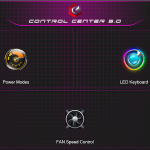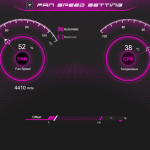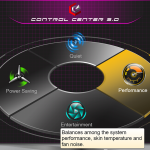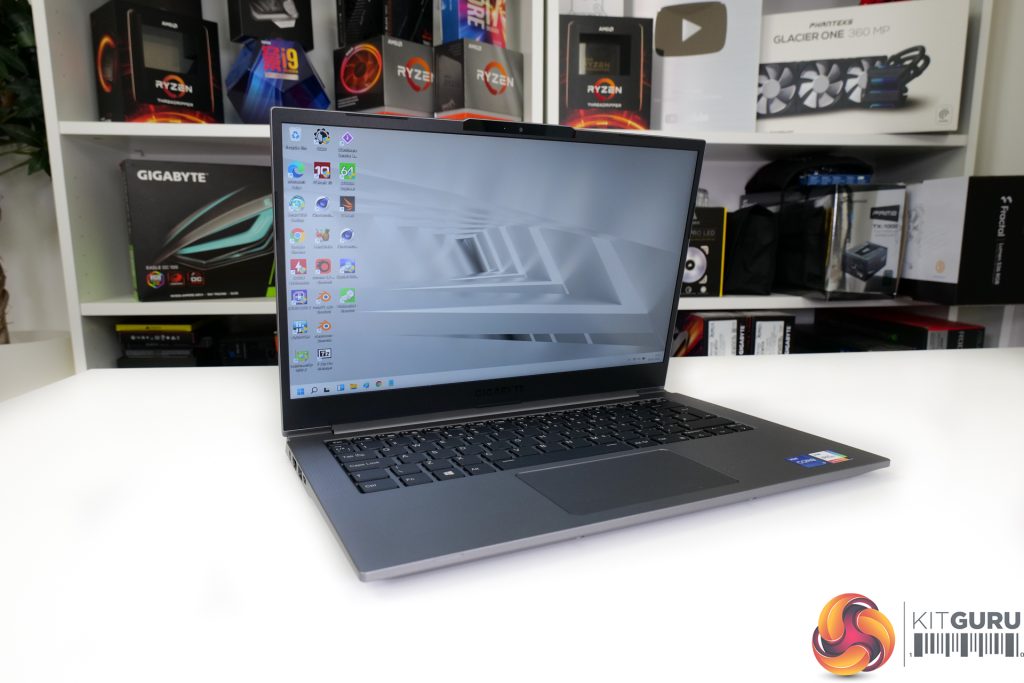We test in the out-of-the-box state with minimal adjustments made to the laptop, other than installing our test software and Windows updates. This is relatively easy because Gigabyte gives us a reasonably clean Windows 11 install with no McAfee or other junk on here.
Under Gigabyte’s control software, we set the laptop to run in its ‘Performance’ mode so that we can see its true horsepower available. There are other power modes available that are probably more sensible for daily usage, though.
Under the ‘Performance’ mode, the Core i7-1195G7 is set as 20W PL1 value, with 51W as the PL2 value. We did not, however, see the chip surpass 45W package power delivered in our heavy all-core check.
The ‘Performance’ mode runs the chip at a package power decreasing towards 26W for around 3.5 minutes. The steady-state package power delivered to the Core i7-1195G7 processor is then 20W.
We include some comparison data from relevant laptops that we have tested recently. Notably, they include a couple of ASUS 13” ZenBooks featuring Ryzen 7 5800U and Core i7-1165G7 processors. So, those two are notable competitors in terms of raw hardware performance data. Even if their form factor and design makes them more expensive and more premium.
Gigabyte U4 UD-70UK823SO Laptop Test Configuration:
- Processor: Intel Core i7-1195G7 (4C/8T, 2.9GHz Base, 28W Rated TDP-up Mode)
- Memory: 16GB DDR4 3200MHz (8GB onboard, 8GB SODIMM)
- Graphics Card: Integrated Intel Iris Xe iGPU (96 EUs)
- Display: 14” 16:9 FHD 1920×1080 60Hz IPS
- System Drive: 512GB ESR512GTLG-E6GBTNB4 PCIe Gen4x4 NVMe SSD
- Battery: 36 Whr battery with 65W barrel-style Power Adapter
- Design: Slightly below 990g weight with 16.5mm chassis thickness
- Operating System: Windows 11
Comparison Systems:
- Razer Blade Stealth 13 OLED (Core i7-1165G7 ‘Tiger Lake’ System)
- Intel Core i7-1165G7 (4C8T, 28W Rated TDP)
- 16GB LPDDR4 4266MHz
- Nvidia GTX 1650 Ti Max-Q
- 13.3″ OLED Full HD Touch 60Hz
- 512GB Samsung NVMe SSD
- 53.1 Whr battery with 100W USB-C Power Adapter
- 1.41kg weight with 15.3mm thickness
- ASUS ZenBook Flip S OLED UX371 (Core i7-1195G7 ‘Tiger Lake-U’ System):
- Intel Core i7-1165G7 (4C/8T, 1.2GHz Base, 12W Rated TDP-down Mode)
- 16GB LPDDR4X 4266MHz
- Integrated Intel Iris Xe iGPU (96 EUs up to 1.3GHz)
- 13.3” 16:9 UHD 3840×2160 60Hz OLED Touch Display
- 1TB WD SN730 NVMe SSD
- 67 Whr battery with 65W USB-C Power Adapter
- 1.2kg weight with 11.9-13.9mm chassis thickness
- ASUS ZenBook 13 UM325S (Ryzen 7 5800U ‘Cezanne' System):
- AMD Ryzen 7 5800U (8C/16T, 1.9GHz Base, up to 4.4GHz Boost, 15W Rated TDP)
- 16GB LPDDR4X 3733MHz
- Integrated Radeon Vega 8 APU (up to 2GHz)
- 13.3” 16:9 FHD 1920×1080 60Hz OLED Display
- 1TB SK Hynix (HFM001TD3JX013N) NVMe SSD
- 67 Whr battery with 65W USB-C Power Adapter
- 1.12kg weight with 13.9mm chassis thickness
Tests
- Cinebench R20 – All-core & single-core CPU benchmark (CPU Compute), Stress test (Temperatures & Power Consumption)
- Cinebench R23 – All-core & single-core CPU benchmark (CPU Compute), Stress test (Temperatures & Power Consumption)
- Blender 2.91.2 – All-core rendering of the Classroom and BMW scenes (CPU/GPU Compute), Stress test (Temperatures & Power Consumption)
- HandBrake H264 – Convert 1440p60 H264 video to 1080p60 H264 using the YouTube HQ 1080p60 preset (CPU)
- HandBrake H265 – Convert 4K30 100Mbps H264 video to 1080p30 40Mbps H265 using the H.265 MKV 1080p30 preset (CPU & Memory)
- 7-Zip – Built-in 7-Zip benchmark test (CPU & Memory)
- SiSoft Sandra – Memory bandwidth and Cache & Memory Latency Test (Memory)
- AIDA64 – Memory bandwidth & memory latency (Memory)
- PCMark 10 – Modern Office & Battery Life Test (System Performance & Battery Life)
- 3DMark – Time Spy (1440p) test, Night Raid (1080p) test (Gaming)
 KitGuru KitGuru.net – Tech News | Hardware News | Hardware Reviews | IOS | Mobile | Gaming | Graphics Cards
KitGuru KitGuru.net – Tech News | Hardware News | Hardware Reviews | IOS | Mobile | Gaming | Graphics Cards






